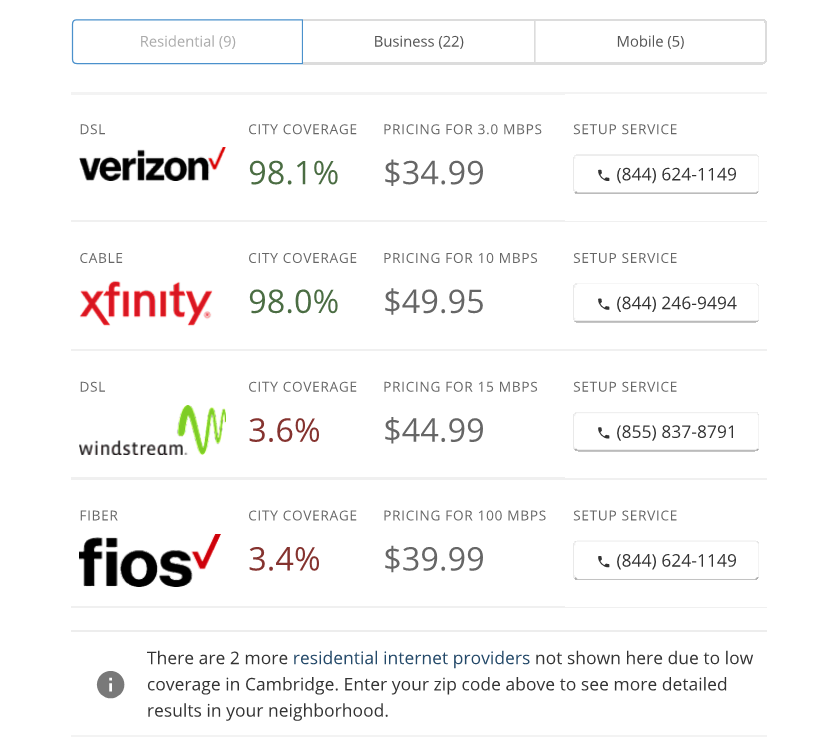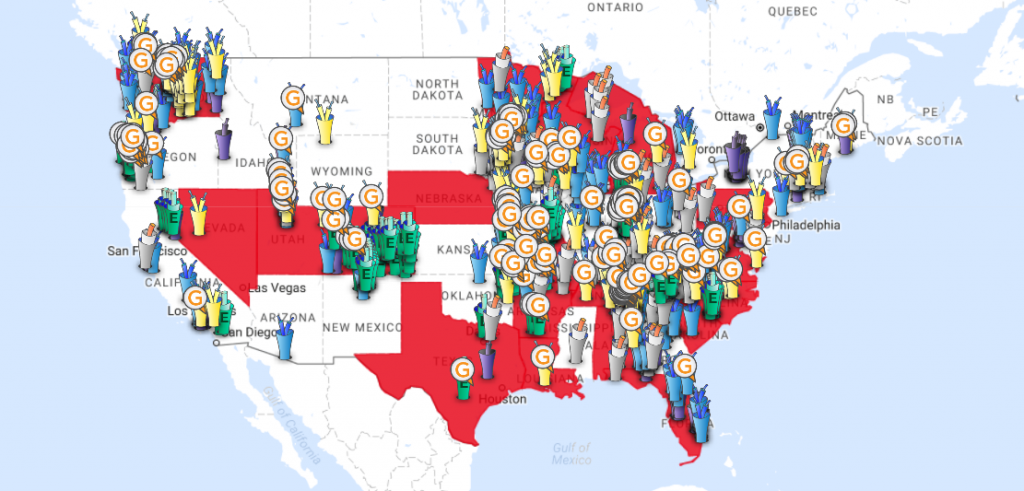
If you’re looking to watch TV without cable, one thing you should know is that you’ll still require internet (unless you just use OTA channels!). Dealing with internet service providers such as Comcast, Xfinity, and Fios is frustrating and usually a big part of why people want to cut cable. However, just because you need internet doesn’t mean that you’re locked into certain providers. Sometimes you can find alternatives to Comcast or other major ISPs that can save you from the headache and more importantly save you money. There are plenty of alternative internet providers, but you have to know where to look.
Xfinity vs Fios vs Comcast
This is the decision most people find themselves in when they are looking for internet without cable. They are familiar with the major three brands of cable and internet that they don’t even know they have other options. There are actually a surprising amount of other options for internet that can help you get rid of cable and still watch TV. The biggest problem with finding these alternative internet providers is that it is completely determined by location. While we can’t recommend the best service provider for you, there are other websites that can. These websites allow you to put in your address and will display multiple different options for internet providers, speed, and prices. We’ve outlined a few of the major sites below.
Broadband Now
Broadbandnow is typically the first site that we like point our readers when they are looking for new ISPs. Similarly to our channel database, broadbandnow maintains a comprehensive database of internet service providers and their service locations. By tracking location as well as pricing and plan information, broadbandnow is able put together a comparison table to show you all the different alternative internet providers you can choose from. It only requires your address, no signups, and gives a quick summary to show you where to look. The screenshot below shows the options at our office location:

In addition this pricing table, they include other tables and graph that show download speeds, public internet service, and a coverage map to illustrate location for each service. One thing we like about broadbandnow is that their database is fairly transparent. They have a tab on their navigation menu that shows you how many total internet service providers they have as well as max speed, states they are located in, and population covered. You can sort it by internet type or search by specific provider name.
According to their table, they have 2693 alternative internet providers at the time of writing this article including Andy Cable, Rise Broadband, and GHz Wireless that you might otherwise never have heard of. Remember that a lot of the pricing on their charts is “1st year only” or “new subscriber” prices and may change after the first year of a two year contract. If you’re already locked into a more expensive plan, the knowledge of these service providers and their offers might provide a good argument to present to your current provider. If you ask nicely and explain the competition, you’d be surprised at how willing some ISPs are to bend.
Municipal Internet
If you’re lucky, there’s a chance that you live in location that has government provided internet as a utility. Recently, we’ve seen towns and cities start to release their own internet and start charging it as a utility rate that is typically much lower than the competitors. Communities will create internet as a utility for a variety of reasons such as price stabilization or economic development. The size of these utilities range from towns connecting a few local business all the way to coverage for hundreds of thousands in Tennessee. It’s completely up to the locality, but more and more places are getting behind it every month.
Muninetwork has a map that shows exactly what it’s name would imply; municipal networks. With federal regulations such as Net Neutrality potentially on the rise, moving internet into the hands of smaller governments might be a huge benefit. If corporations such as Comcast or Verizon start charging for “addon” packages to internet, small local internet treated as a utility might be exactly what we need.

The interactive map seems intimidating at first glance, but once you zoom in and know what you’re looking at it gets a lot better. Each icon represents different types of networks in a specific community. The colors represent FTTH networks, cable networks, fiber (including dark fiber), and if the network speed is at least 1 gigabit. The red states are states that have legislation in place to prevent communities from having their own networks for varying reasons. There’s a lot of information on the map and clicking on each pin will show you a pop-up that includes a link to the network’s website and additional stories about it. These municipal internet connects are typically much cheaper than other options, so make sure you check the map before choosing your provider!
Subsidized Internet and Cable
Internet is quickly become a life essential, particularly when it comes to finding a job. A majority of the country’s largest companies including Wal-Mart and Target require potential employees apply online. The days of walking into a store and asking for an interview are coming to end. Internet doesn’t only have a direct impact on job searches however. Statistics show that students who come from homes with broadband internet service has a 6-8% higher graduation than those without high-speed internet.
If you qualify for a low income internet service there are quite a few options. The major subsidized internet programs are Internet Basics from CenturyLink, Access by AT&T, and Internet Essentials by Comcast. These three programs are a result of the FCC advocating to bring affordable internet to Americans in need.
Internet Essentials by Comcast
Internet Essentials is a low-cost internet service by Comcast that offers discounter computer equipment and free digital literacy training to families that have at least one child that can participate in the National School Lunch Program. The program includes a number of features including:
- 15/2 mbps internet for under $10 a month with no activation fee or rental fees.
- The ability to purchase a computer for $149.99
- Access to free internet training (available online, in person, or a hard copy)
- Free Wi-Fi with your internet
- Access to 40 one-hour long sessions of Hotspots every month for on-the-go internet.
One benefit of Internet Essentials is that it’s available anywhere that other Comcast services are offered meaning that you only need to qualify to receive it.
Internet Basics by CenturyLink
CenturyLink Internet Basics is only offered to residents in Oregon, Tennessee, and Washington. To qualify, you must be able to participate in Section 8, Supplimental Security Income, Medicade, SNAP, or Veterans Pension Benefits. Another option is to qualify due to income for the household. You can find the exact requirements for each state on the internet basics page.
Access by AT&T
Access by AT&T is available to qualifying homes that have at least 1 resident who participates in the SNAP program. Access is available in all 21 states that AT&T’s other services are offered. It makes it more accessible than Internet Basics, but doesn’t have as much coverage as Internet Essentials.
The internet speeds for Access are based on your address. You will be assigned the fastest of the following options:
- 10 megabits per second, for $10 per month
- 5 megabits per second, for $10 per month
- 3 megabits per second, for $5 per month
- 1.5 megabits per second, for $5 per month
- 768 kilobits per second, for $5 per month
Downgrade Your Internet Plan
Another option when you cut the cord is to try and downgrade your internet and cable plan to only cover the internet part. You should note that this is only possible once your contract has expired. Most internet service providers will not let you downgrade your current plan while on a contract unless you pay an early termination fee.
Typically, Comcast and other service providers offer discounts or special offers for the first year of a contract. If you do some research and use Broadbandnow discussed above, or check your service provider’s website, you can gather some valuable information. Calling your provider and asking for a special offer on just internet may allow you to get “first year” prices. Keep in mind that when you’re calculating monthly prices for cutting the cord you need to consider if your cost will increase after the first year. For example, if you’re paying $50 a month for 12 months and then $90 for the second year, your actual monthly price average is $70. Try not to get too focused on the discount price as you might find that your overall monthly price is actually higher than some of your other options.
Although this site focuses on cutting cable, certain packages by cable providers are sometimes the cheapest option even when compared to streaming services. Try not to burn any bridges when you’re cutting the cord so that it doesn’t come back to bite you. Being nice to customer representatives is a lot more likely you get you what you’re looking for than yelling at them.
